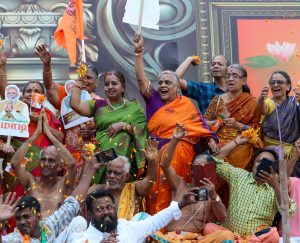Voting in India’s seven-phase general election will begin on April 19. Voters in 102 constituencies in 21 states and union territories across the country will exercise their franchise that day to determine the electoral fate of 1,625 candidates in the fray.
Who will sit in almost 19 percent of the seats in the Lok Sabha, India’s lower house of parliament, will be determined on the first day of voting in India’s 18th general election.
Among the states that will vote in phase one is the southern state of Tamil Nadu, where India’s ruling Bharatiya Janata Party (BJP) is hoping to gain a toehold. All 39 constituencies in the state will vote in phase one.
The main parties in the electoral contest in Tamil Nadu are the Dravida Munetra Kazhagam (DMK)-Congress alliance, the All India Anna Dravida Munetra Kazhagam (AIADMK), and the BJP.
In previous elections, the BJP was the junior ally of the AIADMK. This time around, the two are contesting separately.
The BJP’s electoral performance in Tamil Nadu has been abysmal so far. In the 2019 parliamentary elections, when the BJP won landslide victories across India, the southern states of Tamil Nadu and Kerala stood aloof. The BJP lost the single seat it had managed to win in the 2014 general election in Tamil Nadu and its vote share fell from 5.6 percent in 2014 to 3.66 percent in 2019. The BJP’s best performance in the state was in 1999 when it won four seats in parliament and in 2021, when it secured four seats in the Tamil Nadu assembly.
The BJP’s electoral performance in Kerala is worse than that in Tamil Nadu. The Hindu nationalist party has never won a Lok Sabha seat in the state. It has secured only one seat in the state assembly so far, in 2016.
However, the party’s vote share in Kerala is higher than in Tamil Nadu. In Kerala, the BJP picked up 13 percent of the votes in the 2019 general election. But this dropped to 11.3 percent in the 2021 assembly election.
Kerala and Tamil Nadu have higher literacy and economic development levels than states in northern India, where the BJP’s Hindutva ideology has resonated with the masses. This is believed to be the reason for the BJP’s poor performance in elections in the two states.
Another important reason for the BJP’s minimal influence in Tamil Nadu is the dominant Dravidian ideology and politics in the state. Unlike the Hindi-Hindutva-upper caste ideology of the BJP, which is exclusivist, the Dravidian ideology is not only egalitarian and anti-Brahminical Hinduism, but also Dravidian parties have long-resisted the imposition of the Hindi language on Tamil Nadu.
Since 1967, parties with their roots in Dravidian ideology — the DMK, AIADMK and various offshoots — have been the main political players and formed governments in Tamil Nadu.
However, the influence of Dravidian ideology is declining. This has opened up space for the BJP. And the Modi government has been assiduously wooing Tamil voters over the past five years.
Modi’s speeches reference Tamil literary works and appeal to Tamil pride. The BJP government gave prominence to the “sengol,” a Chola dynasty scepter, during the grand inauguration of the new Parliament building in 2023. In a bid to project itself as the guardian of Tamil interests, the Modi government also raked up a settled dispute with Sri Lanka over the Kachatheevu island to win the support of Tamils.
In addition, Modi has traveled to Tamil Nadu multiple times to inaugurate major infrastructure projects and schemes. Since January this year, he has visited the state seven times and participated in massive road shows and rallies.
While Modi dominates the BJP campaign in the state, the party is also taking care to project a Tamil leader, K. Annamalai, a young former police official who is the BJP’s state unit president. The BJP is hoping Modi and Annamalai will draw the votes of young and first-time voters in Tamil Nadu.
As in Tamil Nadu, in Kerala too, Modi has campaigned vigorously. Kerala’s 20 constituencies will vote in phase 2 on April 26.
For decades, it has been the Left Democratic Front and the Congress-led United Democratic Front that have dominated politics in Kerala. The BJP has been a bit player. Interestingly, the density of Rashtriya Swayamsevak Sangh (RSS) shakas (units) — the RSS is the BJP’s ideological mentor — in Kerala is among the highest in the country. Yet this hasn’t translated into votes for the BJP in the past. Its Hindutva-focused campaigns failed to convince voters to support the BJP.
This time around, the BJP has avoided hardcore Hindutva-focused appeals in Kerala. However, it has not abandoned its communal politics.
The state’s population is 54.73 percent Hindu, 26.5 percent Muslim and 18.3 percent Christian, and the BJP is wooing the support of the Christian community. It has been courting the Christian bishops and clergy. Its allegations that Muslims are waging a “love jihad,” i.e. luring women into marrying Muslim men to convert them, has gained traction among Christians and provided the BJP and Christians with “bonding ground.”
The BJP is also marketing Modi’s development strategy to secure youth support in the state.
The BJP trumpets India’s economic achievements under its rule. However, neither Tamil Nadu nor Kerala has benefited as the Modi government has denied opposition-ruled states funds and their share of resources. Will voters ignore this when they cast their votes?
Despite the BJP’s high-voltage campaigns in the two states with Modi visiting multiple times, latest opinion surveys indicate that the DMK-Congress combine will win all 39 seats in Tamil Nadu and the Congress-led UDF could secure 17 of 20 seats in Kerala.
It seems that at best, the BJP can expect to increase its vote share in Kerala and Tamil Nadu. It may have to wait to open its tally of seats in parliament from the two states.

































